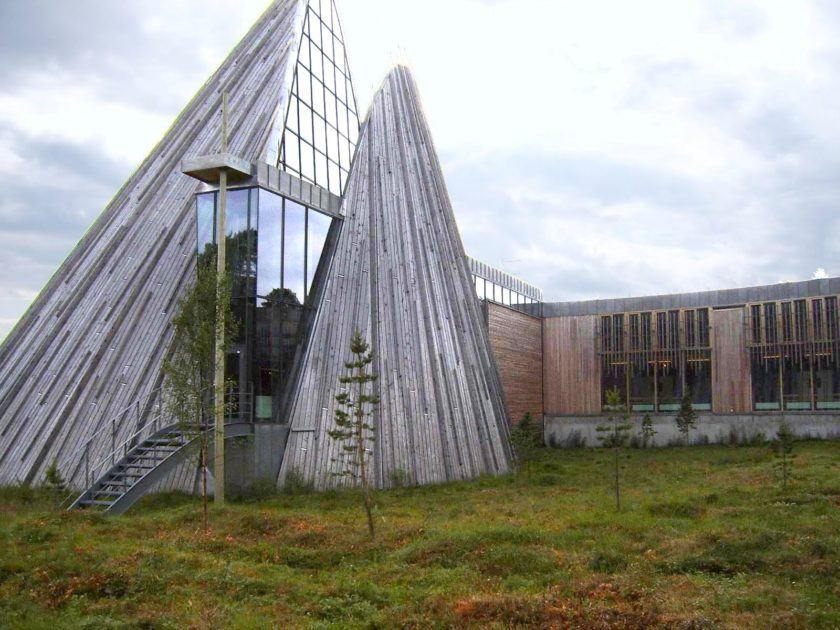This article originally appeared in Counterpunch. Featured image: Sámi Parliament of Norway. Photograph Source: Utilisateur:Bel Adone – Public Domain
On June 23, a coalition of Sámi and environmentalist activists erected a protest camp in Nussir, the projected site of a gigantic copper mine in Sápmi, the traditional homeland of the Sámi people, northern Europe’s indigenous inhabitants. Today, Sápmi is divided by the borders of four nation states: Norway, Sweden, Finland, and Russia. None of these countries have censuses for the Sámi population, and reliable numbers are hard to come by. The use of the Sámi language, the electoral roll of the Sámi parliaments (there is one in each country), and self-identification are important criteria. Roughly, we can speak of about 70,000 Sámi in Norway, 20,000 in Sweden, 10,000 in Finland, and about 2,000 in Russia. For historical reasons, the Russian community is the most isolated.
Nussir lies on the “Norwegian side” of Sápmi, as it is called, near the town of Hammerfest. Mining has been a controversial issue in Sápmi for years. In Sweden, a strong protest movement emerged in 2013, objecting to the plans of opening an iron ore mine in Gállok. While the project is not off the table yet, the protests have caused the Swedish government to put a halt on it and promise a new investigation. This was a partial victory. The same can be said about the Nussir protests. Due to the protest camp and activists chaining themselves to machinery, work on the site has so far been impossible. More importantly, the company that was supposed to purchase the mine’s output, Aurubis, the world’s second-largest copper producer, terminated the “memorandum of understanding” with Nussir ASA in August 2020 due to concerns about “social corporate responsibility”. Whether Nussir ASA can find new investors after this prominent withdrawal remains to be seen.
Mining is not the only issue that threatens the Sámi’s control over their traditional lands and their livelihoods, most importantly reindeer herding and fishing. Wind farms are placed in what many still perceive as “uninhabited territory”, with the turbines making reindeer herding impossible for a radius of many miles. Hydropower plants are already scattered around Sápmi. The allegedly “uninhabited territory” is also used for military exercises, automotive testing, and, increasingly,  geoengineering trials. In Finland, a proposed “Arctic Railway” would cut through traditional reindeer pastures. Along the Deatnu River, which marks the border between Norway and Finland over a stretch of more than 250 kilometers, fishing legislation favors the interests of non-Sámi cabin owners over those of traditional Sámi salmon fishers. In Sweden, clear cuts by the state-owned lumber company Sveaskog threaten the existence of the Forest Sámi and their reindeer herds. All over Sápmi, the crucial question of land ownership remains unresolved, with the governments of Sweden and Finland still refusing to sign the International Labour Organization’ Indigenous and Tribal Peoples Convention (commonly known as ILO 169), while the Norwegian government does not deliver on the promises of the 2005 Finnmark Act that, formally, transferred land ownership in the province of Finnmark to the majority Sámi population.
geoengineering trials. In Finland, a proposed “Arctic Railway” would cut through traditional reindeer pastures. Along the Deatnu River, which marks the border between Norway and Finland over a stretch of more than 250 kilometers, fishing legislation favors the interests of non-Sámi cabin owners over those of traditional Sámi salmon fishers. In Sweden, clear cuts by the state-owned lumber company Sveaskog threaten the existence of the Forest Sámi and their reindeer herds. All over Sápmi, the crucial question of land ownership remains unresolved, with the governments of Sweden and Finland still refusing to sign the International Labour Organization’ Indigenous and Tribal Peoples Convention (commonly known as ILO 169), while the Norwegian government does not deliver on the promises of the 2005 Finnmark Act that, formally, transferred land ownership in the province of Finnmark to the majority Sámi population.
It is interesting to note that many of the named development projects are justified by citing “green energy” and “sustainability”. The planned mine in Nussir has been hailed as “the world’s first fully electrified mine with zero CO2 emissions”. Hydropower and wind power are praised as sustainable alternatives to fossil fuels. Railways as environmentally friendly means of transport. Even geoengineering shall, according to its proponents, help secure the future of our planet. The irony that, in Sápmi, a culture that has proven sustainable for thousands of years is threatened in the process seems to pass by these advocates of corporate environmentalism.
In Sápmi, people increasingly speak of a “green colonialism”. In a speech protesting mining projects, Marie Persson Njajta declared in April 2019: “We have to stop flirting with polluting industries and look at their consequences and their costs. We don’t want green colonialism. Sámi land shall not be exploited yet again, neither for wind power nor for metals to produce electric cars.”
It is ludicrous that, in 2021, there exists such an enormous gap between material justice for indigenous peoples and their symbolic integration into nation-states, which often implies cultural exploitation. At the same time, it is inspiring to see a generation of Sámi activists unwilling to accept this cynicism. Without recognizing the needs, knowledge, and guidance of indigenous peoples, social and climate justice movements will meet serious limitations.


This is not irony. They “name” them green deliberately that pit us against each other in environmental ideological ways. Very clever I would say.